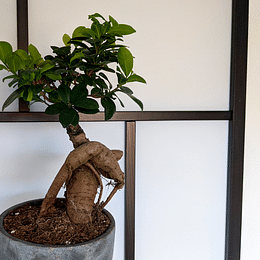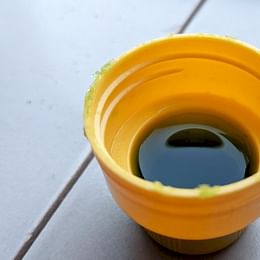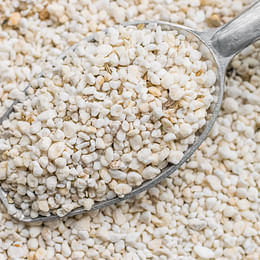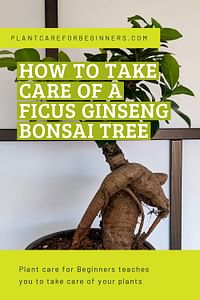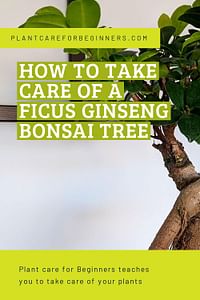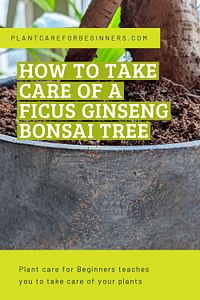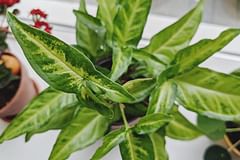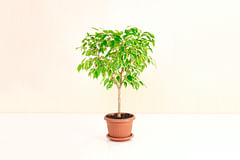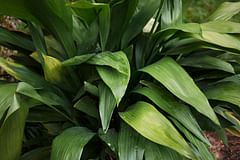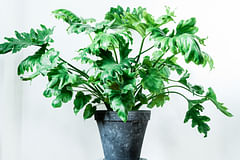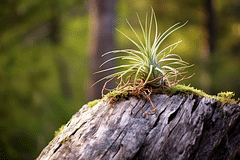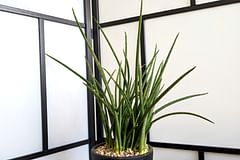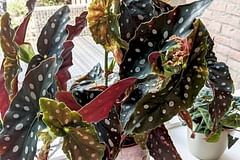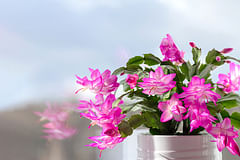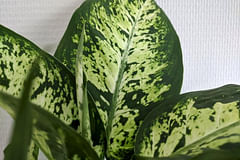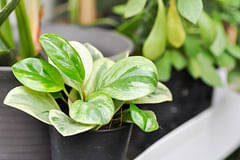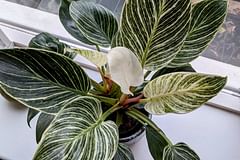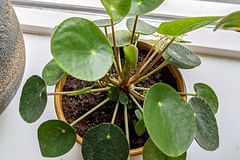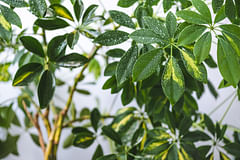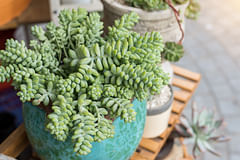How to take care of a Ficus Ginseng Bonsai Tree
In this plant care guide, we're going to look at how you can take care of a Ficus Ginseng, an indoor Bonsai Tree. A lot of Bonsai Trees grow outside, but a select few trees also do well indoors, like the Ficus Ginseng. We'll look at all the basics on how to help your Ficus thrive in your house!
Last updated on:
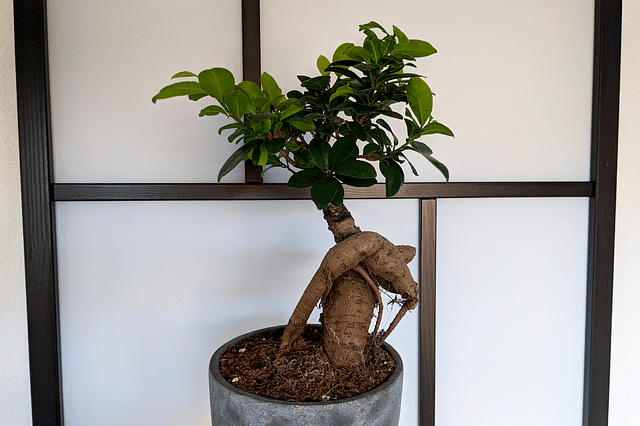
Bonsai trees are beautiful, unique plants that can add an extraordinary look and feel to any room. If you're new to bonsai tree care, don't worry! This plant care guide will teach you everything you need to know to take care of your Ficus Ginseng Bonsai Tree. Together, we'll look at everything from watering and fertilizing to pruning and repotting!
Ficus Ginseng Bonsai Trees are a popular type of indoor bonsai tree. They are easy to care for and have a unique look. In this plant care guide, we're going to look at a few of the most important aspects of taking care of a Ficus Ginseng:
The Ficus Ginseng is a great houseplant for beginners. It's not one of the most difficult plants to take care of, and it's still a beautiful and unique plant. Let's look at how we can give your Ficus the best care we can and help it thrive in your home!
How do you choose a healthy Ficus Ginseng Bonsai tree?
If you're still looking around for a new houseplant and haven't gotten around to picking your Ficus up yet, there are a few things you can look at in the store to make sure you're choosing a healthy plant.
You'll want to look for a tree that has a sturdy, thick trunk and even leaf growth on all sides. It's a good idea to give the trunk a gentle squeeze. If the trunk feels soggy and squishy, you'll want to look at another Ficus, as this one is most likely dealing with root rot. Make sure the leaves are vibrant and glossy, and that there are no signs of pests or disease.
It's also important to choose a tree that is the right size for your space. Remember, you can always help a small plant grow larger, so if you're unsure, pick the smaller plant.
Watering your Ficus Ginseng

As a beginner in bonsai plant care, figuring out the watering schedule for your Ficus Ginseng Bonsai can be a bit of a challenge. You don't want to water it too much and risk over-watering, but it's also important not to under-water it and see your plant wilt away.
Ficus Ginseng Bonsais are native to tropical regions that get high rainfall levels. These plants need regular watering, especially during the growing season, which is between spring and fall.
Ways to prevent overwatering
A Ficus Ginseng enjoys moist soil most of the time but doesn't like to have wet feet. When your Ficus is exposed to too much water for too long, it will quickly develop root rot and die. Luckily, there are a few things you can do to make sure this doesn't happen.
- Only water your Ficus when the soil is completely dry
- Use a pot with a drainage hole to drain excess water from the pot
- Use well-draining soil to hold onto some of the water, but not too much
When watering your Ficus, be sure to water it thoroughly and then allow the soil to dry out completely before watering again. Watering your plant thoroughly makes sure that all the soil has a chance to soak up the moisture before draining it to the bottom of the pot. Overwatering is one of the most common problems with ficus trees, so wait until the soil is completely dry.
Check the soil regularly
You should also check the soil moisture level regularly, especially before watering. By checking the soil, you can tell if your Ficus Ginseng needs more water or if it might have gotten too much. One way to check the soil is by sticking your finger about an inch deep into the soil. If it feels dry, then give your plant a good watering. If the soil feels moist, wait for a day or two before checking again. Over time, you'll start to learn how often your Ficus Ginseng Bonsai needs watering.
If your Ficus has been dry for too long, it tends to drop a few brown and crispy leaves, so make sure to water before that happens. This might take a little experimentation, but on average you should water your Ficus Ginseng once every 7 days.
What are some signs of overwatering or underwatering a Ficus Ginseng?
One of the most common mistakes made by plant owners is overwatering or underwatering their plants. So let's look at a few signs to help you find out if your plant needs more or less water.
Signs of overwatering include yellowing of the leaves, soft and mushy leaves or stems, and leaf drop. Overwatering can lead to root rot, which is a fungal disease that occurs when the roots are sitting in water for too long. The soil may also start to smell funky.
On the other hand, underwatering causes the leaves to dry out and turn brown, and the branches become brittle. The soil may also appear dry and pull away from the edges of the pot. If it's dry for too long the plant may start to wilt, and the leaves will turn crispy and fall off.
To prevent these issues, regularly check the soil with your fingers or a moisture meter.
How much sunlight exposure does your Ficus Ginseng need?
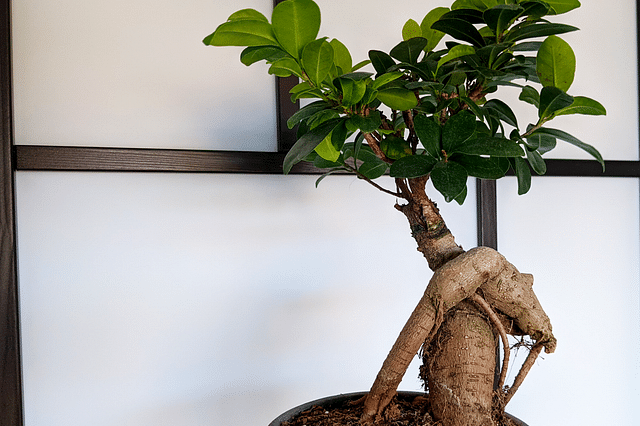
Your ficus tree will need plenty of bright, indirect light. If you notice that the leaves are starting to turn yellow or brown, it's a sign that your Ficus Ginseng is getting too much sunlight. Bright and indirect sunlight is ideal, but a few hours of direct sunlight in the morning is fine too, as long as it doesn't get the stronger direct sunlight in the afternoon. The direct sunlight in the afternoon will be too bright and warm for this plant.
An east or west-facing window can be a great choice for this plant. It allows the Ficus Ginseng to enjoy a few hours of softer morning or evening sunlight while avoiding the harsh afternoon rays. If you don't have a suitable window, placing the Ficus Ginseng in a well-lit room where it can receive ambient daylight can also work.
Finding the perfect balance of light for your Ficus Ginseng may require a little trial and error, but your plant will show you what it needs. Monitor your plant's response to the light conditions and adjust accordingly.
Temperature and Humidity requirements
When caring for Ficus Ginseng, it's important to stay within the ideal temperature and humidity range to give your plant the best chance of success. The Ficus Ginseng thrives in warm, tropical climates and prefers temperatures ranging from 18 to 24 degrees Celsius (65 to 75 F). Luckily, these temperatures are usually the indoor temperature of your home already.
It's important to avoid exposing your Ficus to extreme temperatures and sudden temperature changes, as this can harm the plant and stunt its growth. It's recommended to keep the Ficus Ginseng away from drafty windows, radiators/heating units, and air vents.
To help your Ficus even more, it's important to give it consistent humidity levels. The ideal range is between 50% and 70%. If your home is quite dry, you can achieve these humidity levels by placing a tray filled with water close to the Ficus or misting the leaves lightly with water every few days.
What is the best type of soil for Ficus Ginseng?
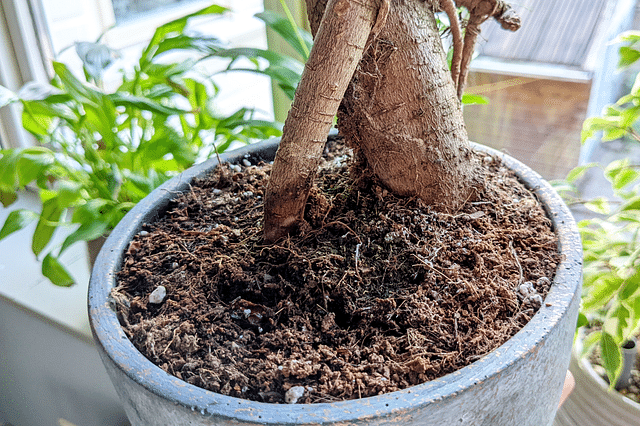
When it comes to finding the best soil mixture for Ficus Ginseng, there are a few things to keep in mind. The first is that the Ficus Ginseng prefers moist soil but should also drain excess moisture quickly. The Ficus Ginseng doesn't like to stand in a puddle of water.
The best soil mixture for this bonsai tree is a well-draining potting mix. You can find this at most garden stores or online. This well-draining soil mix is also quite easy to mix yourself. You can mix your soil for the Ficus Ginseng by mixing 2 parts potting soil with 1 part peat moss and 1 part perlite.
To prevent the plant from standing in a puddle of water, I recommend getting a pot with a drainage hole. This helps the excess moisture to escape the pot and will help you to prevent root rot.
When do you fertilize your Ficus Ginseng?

To keep any houseplant healthy for a long time, you'll need to fertilize it during the growing season in the spring and summer. The Ficus Ginseng is no different.
Fertilize your ficus tree every few weeks during the growing season with a balanced liquid fertilizer (10-10-10 or 20-20-20 NPK is ideal). All fertilizers are different, so make sure to follow the instructions on the packaging carefully. If you fertilize too often or with too much fertilizer, you can burn the roots of your ficus tree.
If you're using a liquid fertilizer, don't forget to dilute it with water. The packaging usually has a ratio of fertilizer to water. Stick to this ratio for the best results. If you apply the liquid fertilizer to the plant without diluting it, you risk overfertilizing your plant, which can lead to root burn.
During the fall and winter, you shouldn't fertilize your Ficus Ginseng, as it'll be in its dormancy and won't need the fertilizer. As soon as it gets to the end of winter (beginning of March in the north), you can start to fertilize your Ficus again, as this is the early spring and your Ficus is about to grow quite quickly.
What type of fertilizer should be used for Ficus Ginseng?
In the previous section I mentioned using a liquid fertilizer, but if you have slow-release fertilizer on hand, this is fine as well. The type of fertilizer you use is generally up to what you prefer. I prefer a liquid fertilizer because I can add it to the water when watering my plants. It's convenient.
If you've got fertilizer balls or sticks that last about 100 days, you can use these as well, as long as they're balanced (10-10-10 or 20-20-20 NPK). Add these to the soil in the early spring and you don't have to think about fertilizing your plants again until the early summer. It's a great choice for those who tend to forget to fertilize their plants.
When fertilizing your houseplants, make sure to use a fertilizer that is specifically designed for indoor plants as outdoor fertilizer may be too harsh and cause root damage.
How do you protect a Ficus Ginseng from extreme conditions?
Most houseplants, including Ficus Ginseng, are sensitive to extreme temperature and humidity changes. Because of this, you'll need to move your plants around in your house during the different seasons of the year.
During hot summer weather, it's important to keep your Ficus Ginseng in a location that is shaded from direct sunlight, as direct sunlight can cause sunburns on your plant. During this warmer time of year, you'll also need to water your plant a little more often as the moisture in the soil evaporates more quickly. If you regularly check the soil, you'll find a schedule that works well for you.
On the other hand, during the winter months, when temperatures are low and the air is dry, you should keep your Ficus Ginseng away from cold drafts or heaters. Cold and dry air will dry out your Ficus too quickly and can cause permanent damage. Your Ficus Ginseng will also need less water compared to how much it needs in the summer.
Can a Ficus Ginseng Bonsai be placed outdoors?
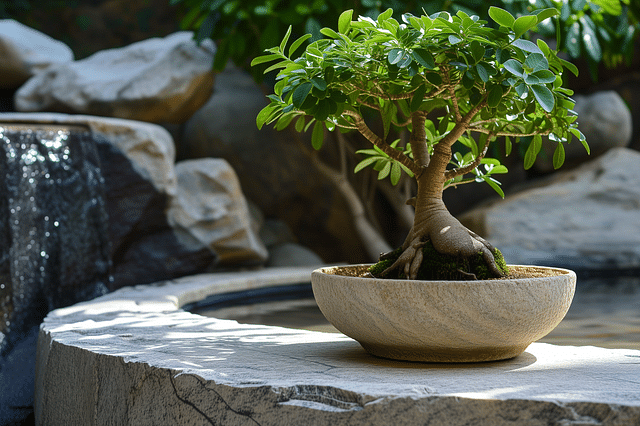
The Ficus tree species is native to tropical regions where they get a lot of indirect sunlight. This Ficus tree needs a lot of light to remain healthy and vibrant. So, if you are wondering if you can place your Ficus Ginseng Bonsai outdoors, you're in luck, you can!
Keep in mind that the Ficus Ginseng is sensitive to cold weather. You want to make sure that you move the Ficus indoors if the temperature drops below 18 degrees Celsius (65 F).
Also, too much direct sunlight can cause the leaves to burn, so it is best to place your Ficus tree in a shaded spot where it can still receive plenty of indirect sunlight but is not exposed to too much heat from the sun.
The last thing to pay attention to is your Ficus Ginseng Bonsai's watering needs. While it is outside, you may need to water it more often than when kept indoors. How often you'll need to water it depends on the temperature and the humidity, so be sure to regularly check the soil yourself.
When should you prune your Ficus Ginseng?
Pruning your plants is a great way to promote growth, get rid of dead leaves, and shape your plants exactly how you want! Just like any other houseplant, you can and probably should prune your Ficus Ginseng as well!
You should prune your Ficus in late winter or early spring before any new growth begins. Prune off any dead or damaged branches with sharp, clean scissors or pruning shears. If you're using your Ficus as a true Bonsai, this is the perfect time to shape your tree how you'd like it to look! Be careful not to prune too much, as this will reduce the amount of foliage and sap production.
Are there any specific pruning techniques for Ficus Ginseng?
If you're looking to keep your Ficus Ginseng healthy and looking its best, proper pruning techniques are essential. There are a few specific techniques you can use to keep your plant thriving.
First, make sure to remove any dead or damaged branches or leaves regularly. This will not only keep your plant looking tidy, but it will also help prevent any diseases or pests from taking hold.
You can use a technique called directional pruning to help shape your Ficus Ginseng. To do this, simply prune back any branches or shoots that are growing in the wrong direction, or that are becoming too long or unruly.
You can also use a technique called pinching to encourage new growth and maintain the shape of your plant. To do this, simply use your fingers to pinch back any new shoots or buds that are growing in unwanted places. These shoots are usually tender, which makes them easy to pinch off. Be sure to only pinch the very tip of the new growth, leaving the majority of the new branch intact.
Unlike when most pruning techniques can be used, pinching should only be done during the growing season, primarily in the spring and early summer when the tree is actively producing new growth.
When should you repot your Ficus Ginseng?
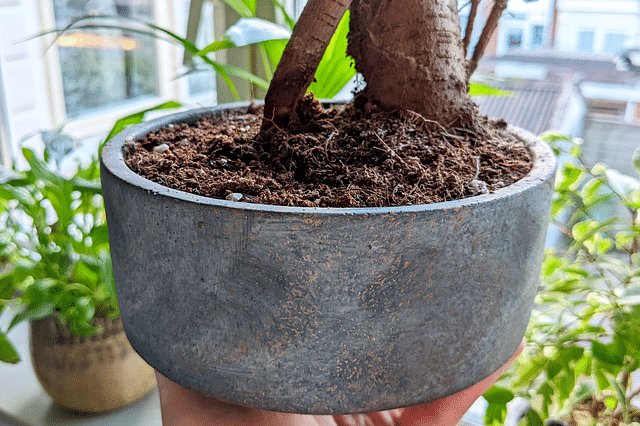
Your Ficus Ginseng probably grew quite a bit if you've taken excellent care of it for a year or more. However, now it seems to have stopped growing in the middle of spring or summer. This means it might be time to repot your plant!
You know your Ficus needs to be repotted when the plant becomes root-bound. You can easily see if your Ficus is root-bound by carefully lifting it out of the pot to check the roots. If you see more roots than soil and if the soil is very tightly packed around the roots, your plant is officially root-bound. Repotting the Ficus Ginseng in a bigger pot will give the plant more space to grow and will help keep it healthy.
The best time to repot a Ficus Ginseng is in the springtime when the plant is coming out of its winter dormancy. You should wait until the soil is dry to the touch before repotting, and then gently remove the plant from its pot. If the roots have grown out of control, you can cut them back with sharp, clean scissors before repotting.
If you're using a shallow pot, trimming the roots a little is a great idea, because this keeps the roots compact and helps with the overall health of your Ficus. Be sure to choose a pot that is only slightly larger than the original pot, and pack fresh soil around the roots before watering well.
It's very important to use a pot that's only slightly bigger than the current pot because if you plant your Ficus in a pot that's far too large, it's very easy to overwater your plant and cause root rot.
How do you choose the right time to repot a Ficus Ginseng?
One of the key signs that it's time to repot your Bonsai is when its roots start to grow out of the drainage holes at the bottom of the container. Another sign is if you notice that the soil dries out much more quickly than before.
If you're unsure, gently tap the sides of the container to see if the roots are tightly packed against the inside of the container. If they are, it's time to repot your Ficus Ginseng.
The steps of repotting a Ficus Ginseng Bonsai

Repotting a Ficus Ginseng Bonsai is important for it to stay healthy for many years. I recommend repotting it once every two years in the spring, just before the growing season begins. Here are some steps you can follow:
- Carefully remove the bonsai from the current pot. If the roots are tangled or circling the inside of the pot, gently untangle them and trim back any roots that are too long to encourage new root growth. Also, make sure to remove any dead or damaged roots.
- Prepare the new pot by filling it with a layer of well-draining soil.
- Place the bonsai on top of the soil in the new pot and position it so that it is straight and centered. Add more soil around the roots and push it down lightly to remove any air pockets.
- Water the Ficus thoroughly, making sure that the soil is moist but not soaked.
- Place the bonsai in a location where it will receive plenty of bright indirect sunlight and humidity.
With these simple steps, you can make sure that your Ficus Ginseng continues to grow and thrive for years to come. The best part: you don't have to think about repotting your plant for at least 2 years!
Pests on your Ficus Ginseng
Ficus trees are relatively easy to care for, but like all plants, they can be susceptible to pests and diseases. The two most common pests you can find on Ficus Ginseng are scale insects and mealybugs. Other pests may that can affect your Ficus Ginseng including spider mites, aphids, and whiteflies. These pests can cause damage to the leaves and branches of the tree, and can also lead to the development of fungal diseases.
If you notice any signs of a pest infestation, take action immediately to get rid of them. You can get rid of most of these pests by using insecticidal soap, neem oil, or simply wiping the pests off with a damp cloth. Be sure to check your Ficus regularly for any signs of problems and take action immediately if you see anything out of the ordinary.
Spider mites
Spider mites are tiny arachnids that are difficult to see with the naked eye. They feed on the sap of the Ficus and can cause damage to the leaves, causing them to turn yellow and wither away. Other than neem oil, you can also get rid of spider mites by spraying your tree with a combination of water and dish soap.
Scale insects
Scale insects are small, immobile insects that can attach themselves to the leaves and stems of your Ficus Ginseng, causing yellowing and the appearance of white spots.
Aphids
Aphids are small, soft-bodied insects that typically feed on the underside of the bonsai's leaves. They suck out the sap and cause damage to the plant's growth. Aphids can be controlled with a strong spray of water or by introducing ladybugs, a natural predator of aphids. You can purchase ladybugs at your local garden center.
Whiteflies
Whiteflies are small white insects that also feed on the sap of the Ficus Ginseng. They can cause stunted growth and yellowing of leaves. These are small, winged insects that can easily be disturbed when watering your Ficus. They leave a white powdery substance on the leaves.
Neem oil is a last resort for removing whiteflies from your tree. The easiest way is to use sticky traps around your plant.
Mealybugs
Mealybugs are also common pests that feed on the sap of your bonsai. They leave a white, cottony residue on the leaves. In addition to using neem oil to rid your bonsai of mealybugs, you can also use a cotton swab dipped in alcohol.
How do you prevent pests from infesting a Ficus Ginseng Bonsai?
To prevent pests from infesting your Ficus Ginseng, there are several things you can do. First, keep your tree healthy by providing it with good care, including appropriate watering, fertilization, and sunlight. This will help to keep your tree strong and less vulnerable to pests.
Regularly inspect your tree for any signs of pests such as webbing, holes in the leaves, or discolored patches. If you do see any signs of an infestation, act quickly to address it to prevent spreading.
Another way to prevent pests from infesting your Ficus Ginseng is to keep it clean and free of debris. This means regularly removing dead leaves and pruning any dead or diseased branches. Pests love clutter, so by keeping your tree clean and tidy, you can minimize the risk of an infestation.
Finally, be careful when introducing new plants or soil to your plant. Always inspect them for pests before bringing them home, and make sure that any soil you use is sterile and free of pests or pathogens.
Is Ficus Ginseng toxic to pets?
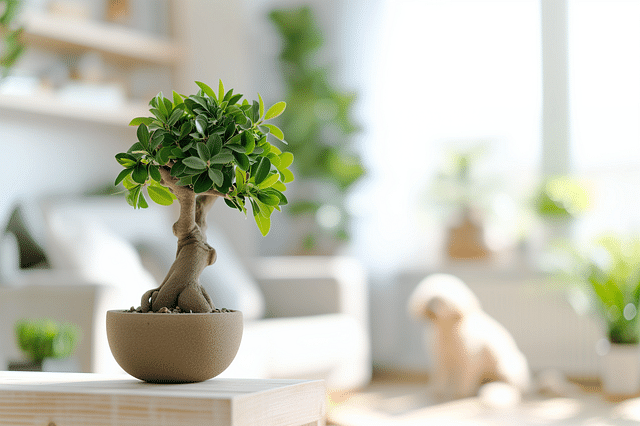
Many tropical houseplants are toxic to pets. Unfortunately, Ficus Ginseng is not an exception to this and is toxic for your pets.
The leaves and sap from Ficus Ginseng are toxic to cats and dogs. These toxins can cause skin irritation, vomiting, and diarrhea. If your pet has eaten the stems or leaves, the toxins can cause liver damage and even death. Pets should be kept away from this plant if possible. If you notice that your pets have eaten from your Ficus, make sure to call your veterinarian right away!
Conclusion
Thank you for following my guide on how to take care of your Ficus Ginseng! Whether you're a veteran plant owner or a newbie, this guide has given you all the tips and tricks you need to help your Ficus Ginseng Bonsai tree healthy.
By watering it, exposing it to sunlight, fertilizing it, and keeping an eye out for pests, your ficus tree will thrive indoors and provide you with years of enjoyment. And remember, the journey with your Ficus Ginseng Bonsai is just as important as the destination. Be sure to share this guide with your friends and family so they can take care of their plants too!
Thank you for reading this post! I hope it helps you to keep your plants healthy and beautiful! If you're looking for more guides on specific plants, you can always request a plant guide to get a guide for the plant you have trouble with.
Tags: beginner-friendly, Plant care tips, tropical
Posted on: Aug 20, 2022 Last updated on: Jan 25, 2024